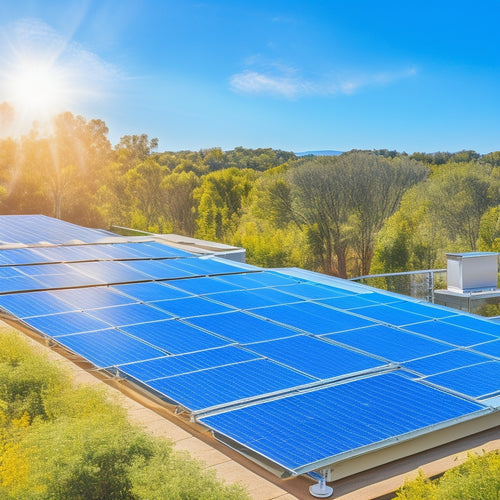
Safety Precautions for Portable Power Equipment
Share
To guarantee safe operation of portable power equipment, you need to follow critical safety precautions. Regular maintenance is essential; inspect fuel quality and connections to avoid failures. Assess your power requirements and select the right equipment based on wattage needs. Familiarize yourself with user-friendly controls to minimize operating errors. Consider usage duration to prevent overheating and guarantee efficient performance. Be mindful of the environment where you operate; lightweight and portable designs enhance mobility and reduce fatigue. By prioritizing these precautions, you can maintain safety and efficiency while using your equipment, and more perspectives await you.
At a Glance
- Regularly inspect and maintain portable power equipment to ensure reliability and prevent malfunctions during emergencies.
- Follow manufacturer guidelines for safe operation and prioritize electrical safety to avoid hazards.
- Assess your power requirements to choose the appropriate portable power solutions for your specific needs.
- Ensure easy access to controls and user-friendly interfaces to minimize operation errors and enhance safety.
- Monitor usage duration to prevent overheating and maintain optimal performance, adhering to recommended limits.
Proven Reliability in Emergencies
In emergencies, having reliable power solutions is essential for maintaining safety and functionality.
Regular maintenance of your portable power equipment guarantees it operates effectively when you need it most.
Emergency Power Solutions
When the power goes out unexpectedly, having a reliable emergency power solution can make all the difference.
Solar generators offer a sustainable option, utilizing sunlight to provide energy during power outages. They're quiet and require minimal maintenance, making them ideal for disaster preparedness.
Battery backups are another essential tool, storing energy to keep important devices running when the grid fails.
Incorporating emergency lighting guarantees you won't be left in the dark, enhancing safety and visibility.
Portable chargers are indispensable for keeping phones and other essential devices powered, facilitating communication during crises.
Consider the fuel sources for your equipment.
Inverter systems can convert DC power from batteries into AC power, allowing you to run household appliances while surge protection can safeguard your electronics from damage.
Prioritizing electrical safety is significant; always follow manufacturer guidelines and regularly check your equipment.
Equipment Maintenance Importance
Regular maintenance of portable power equipment is essential for guaranteeing its reliability during emergencies. When you rely on these tools, you can't afford any failures. Implementing preventative measures, such as regular inspections, not only prolongs the life of your equipment but also assures peak performance when you need it most.
Start by checking fuel levels and quality; stale fuel can cause engine issues. Inspect battery connections for corrosion, as poor connections can lead to power failures. Additionally, confirm that all mechanical parts are lubricated and free from debris. This attention to detail helps maintain smooth operation, especially in critical situations.
Don't overlook the importance of testing your equipment under load. Regularly verify that generators can handle the required output without straining. Document your inspections, as this creates a reliable maintenance history, allowing you to identify trends or recurring issues.
In essence, staying proactive with your maintenance routine isn't just a best practice—it's a necessity. By committing to these essential tasks, you equip yourself with the confidence that your portable power equipment will perform reliably when it matters most.
Enhanced Mobility and Flexibility
When you consider portable power equipment, increased accessibility and lightweight design are essential factors.
Foldable solar panels, for instance, offer an ultra-light design that can weigh as little as 3.9 oz, making them an ideal choice for enhancing mobility.
These features not only enhance mobility but also allow you to easily transport and operate tools in various environments.
Understanding how these advantages contribute to efficiency can greatly improve your overall experience with power equipment, especially when considering reliable off-grid energy solutions for outdoor excursions.
Increased Accessibility Benefits
With the rise of portable power equipment, users enjoy enhanced mobility and flexibility that greatly enhance their work efficiency. This accessibility allows you to tackle projects in various locations without being tethered to a power source. You can easily transport your tools, whether you're working on a construction site, landscaping, or home improvement tasks. This newfound freedom can markedly reduce downtime and increase productivity.
Moreover, the ability to access power where and when you need it enhances user safety. You no longer have to worry about tripping over cords or being restricted by fixed power outlets. Instead, you can focus on your work, knowing that you have the tools you need within reach. This leads to a more streamlined workflow, allowing you to complete tasks more efficiently.
In addition, portable power equipment often comes equipped with features that prioritize user safety. By ensuring power accessibility without compromising safety, these tools enable you to operate confidently and effectively.
Ultimately, the increased accessibility benefits of portable power equipment provide you with the freedom to work in diverse environments while maintaining a focus on safety and efficiency.
Lightweight Design Advantages
The lightweight design of portable power equipment greatly improves mobility and flexibility, allowing you to maneuver effortlessly in various work environments. This enhanced mobility isn't just a convenience; it opens up opportunities for efficiency and productivity.
With lightweight materials, you can easily transport your equipment from one location to another without the physical strain typically associated with heavier models.
Portability benefits become particularly evident when you're working in tight spaces or uneven terrain. You'll find that lightweight equipment is easier to handle, reducing the risk of accidents caused by awkward lifting or carrying.
This design consideration not only enhances your operational capability but also promotes a safer work environment, as you're less likely to experience fatigue that can lead to mistakes.
Moreover, the combination of lightweight construction and power guarantees that you get the job done without sacrificing performance. You can swiftly adapt to various tasks, whether it's a DIY project at home or a job site requirement.
Ultimately, the lightweight design of portable power equipment enables you to work more freely and efficiently, making it an essential asset in today's fast-paced world.
User-Friendly Control Interfaces
When using portable power equipment, intuitive design features and easy access controls are essential for your safety and efficiency. A user-friendly interface minimizes the risk of errors, allowing you to focus on the task at hand rather than struggling with complex controls.
Additionally, incorporating off-grid solar power systems can enhance your experience, as they often come with user-friendly interfaces that simplify energy management while camping in remote areas off-grid solar power.
As a result, evaluating these design aspects can greatly enhance your overall experience and safety.
Intuitive Design Features
Although advanced technology often complicates user interactions, intuitive design features in portable power equipment enhance accessibility and efficiency. By prioritizing user experience, manufacturers integrate ergonomic features and intuitive interfaces that simplify operation and reduce the learning curve.
You'll find that well-placed controls and easily navigable menus allow you to focus more on your tasks rather than fumbling with complicated setups.
Consider how ergonomic features, such as adjustable handles and comfortable grips, provide you with a more natural and less strenuous operation. Intuitive interfaces often incorporate color-coded buttons and visual indicators, ensuring that you can quickly identify functions, even in low-light conditions.
This simplicity in design not only elevates your confidence but also minimizes the risk of accidents caused by confusion or misoperation.
When you employ equipment designed with these principles in mind, you gain an enhanced sense of control and freedom. You're not just using tools; you're engaging with intelligent systems that respond to your needs.
Ultimately, intuitive design features in portable power equipment enable you to work more efficiently, safely, and enjoyably.
Easy Access Controls
User-friendly control interfaces in portable power equipment greatly improve operational efficiency and safety. When you're working with various tools, intuitive access to controls allows for quick adjustments and immediate responses, minimizing downtime.
Proper control ergonomics guarantees that buttons and levers are positioned for easy reach, reducing strain and fatigue during prolonged use.
Moreover, adhering to safety standards is critical. Equipment designed with user-friendly interfaces often incorporates visual cues and tactile feedback, so you can operate machinery confidently and accurately.
This design philosophy not only nurtures a sense of freedom while working but also enables you to maintain control over your tasks without unnecessary complications.
Consider features like large, clearly labeled buttons and responsive touchscreens, which improve usability. These elements are particularly important in high-pressure situations where split-second decisions may affect both safety and productivity.
By choosing equipment with easy access controls, you're not just increasing efficiency; you're also prioritizing your safety and well-being.
In this way, portable power tools can become extensions of your capabilities, allowing for seamless operation and greater creative freedom in your projects.
Assess Your Power Requirements
To effectively assess your power requirements, start by determining the specific power needs of your equipment.
Consider not only the wattage each tool requires but also how long you'll be using them continuously. This analysis guarantees you select a portable power source that meets your demands without risking overload or inefficiency.
Additionally, evaluating your energy needs can help you choose between various portable energy solutions that are designed for different applications, from camping to off-grid living.
Determine Equipment Power Needs
Evaluating your power requirements is vital for guaranteeing that your portable power equipment operates efficiently and safely. To achieve this, you'll need to perform a power calculation. This process involves determining the wattage needed for each tool or device you plan to use. Understanding these requirements not only maximizes energy efficiency but also helps prevent equipment overloads.
Here's a simple table to clarify how to assess your equipment's power needs:
| Equipment | Power Requirement (Watts) |
|---|---|
| Power Drill | 600 |
| Circular Saw | 1,500 |
| Portable Heater | 1,500 |
| Air Compressor | 1,200 |
| Electric Chainsaw | 1,000 |
As you analyze each piece of equipment, add up the total wattage to determine your overall power needs. This calculation guarantees you choose a generator or power source that meets or exceeds your requirements. Remember, prioritizing energy efficiency not only conserves resources but also enhances the performance and longevity of your tools. So, take the time to assess your power needs – it's vital for a safe and effective operation.
Consider Usage Duration
Evaluating your power requirements also involves considering how long you'll be using each piece of equipment. Understanding the duration limits for your portable power tools is vital for both performance and safety.
If you plan on extended use, it's important to consult the usage recommendations specific to each device. Many manufacturers provide guidelines that indicate how long you can operate their equipment safely without overheating or causing damage.
For instance, continuous use of a generator often requires breaks to prevent overheating. If you're working on a project that demands several hours of operation, you'll need to factor in these breaks, ensuring your equipment remains within its safe operating limits.
Additionally, consider the power draw over time; some tools may not perform at their best if used continuously beyond their recommended duration.
Lower Operating Costs Overall
When you choose portable power equipment designed for efficiency, you greatly lower your maintenance expenses.
These units often require less frequent servicing due to their sturdy construction and advanced technology.
Reduced Maintenance Expenses
Regularly maintaining portable power equipment can greatly cut costs over time, leading to reduced maintenance expenses. When you adopt effective cost-saving strategies, you'll find that proactive maintenance notably lowers the likelihood of costly repairs or replacements.
By adhering to maintenance tips such as checking fluid levels, cleaning air filters, and inspecting belts and hoses, you can guarantee your equipment runs smoothly and efficiently.
Implementing a scheduled maintenance routine not only extends the lifespan of your equipment but also optimizes its performance. This means you'll spend less on fuel and energy, as well-maintained machines operate more efficiently.
Additionally, keeping a detailed maintenance log helps you track expenses and identify patterns, enabling you to refine your cost-saving strategies further.
Investing time in maintenance pays off, as it minimizes downtime and maximizes productivity, allowing you to focus on your work without interruption.
Remember, neglecting maintenance can lead to unexpected breakdowns, skyrocketing repair costs, and ultimately, a loss of freedom in your operations.
Frequently Asked Questions
What Personal Protective Equipment Should I Wear When Using Portable Power Equipment?
When using portable power equipment, you should wear sturdy gloves for grip and cut protection. Eye protection's essential too; choose safety goggles or a face shield to guard against flying debris and potential hazards.
How Can I Safely Store Portable Power Equipment When Not in Use?
When you're not using your portable power equipment, think of it like a well-organized toolbox. Maintain ideal storage conditions, keep it dry, and guarantee equipment organization to extend its life and enjoy freedom in your projects.
What Are the Signs of Equipment Malfunction to Look Out For?
When evaluating equipment performance, watch for malfunction indicators like unusual vibrations or excessive heat. Additionally, listen closely for abnormal equipment noises, as they often signal potential issues needing immediate attention to guarantee peak functionality.
How Often Should Portable Power Equipment Be Inspected for Safety?
You should inspect portable power equipment regularly, ideally every month, to guarantee peak performance. Incorporate this into your maintenance schedule, adjusting inspection frequency based on usage intensity and environmental conditions to maximize equipment longevity and reliability.
What Should I Do in Case of an Emergency While Using the Equipment?
In an emergency, stay calm and follow your emergency procedures. Assess the situation, call for help if needed, and administer first aid if you're trained. Remember, quick actions can save lives and maintain freedom.
Explore More
When you rely on portable power equipment, prioritizing safety precautions isn't just a suggestion—it's a necessity. Imagine the peace of mind you'll gain, knowing you've assessed your power requirements and chosen equipment with proven reliability. As you steer through enhanced mobility and user-friendly interfaces, remember that even the slightest oversight can lead to unexpected challenges. So, take the time to implement these safety measures; your future self will thank you when you face those critical moments with confidence.
Related Posts
-

Top Eco-Friendly Camping Equipment for a Sustainable Adventure
When you're camping with the planet in mind, opt for eco-friendly gear like tents made from recycled materials and bi...
-

What Types of Solar Energy Devices Are Available
You'll find several types of solar energy devices available today, each customized to different energy needs. Photovo...
-

Designing a Green Roof for Maximum Energy Efficiency
Designing a green roof for maximum energy efficiency involves several key strategies. Start by selecting native, drou...


